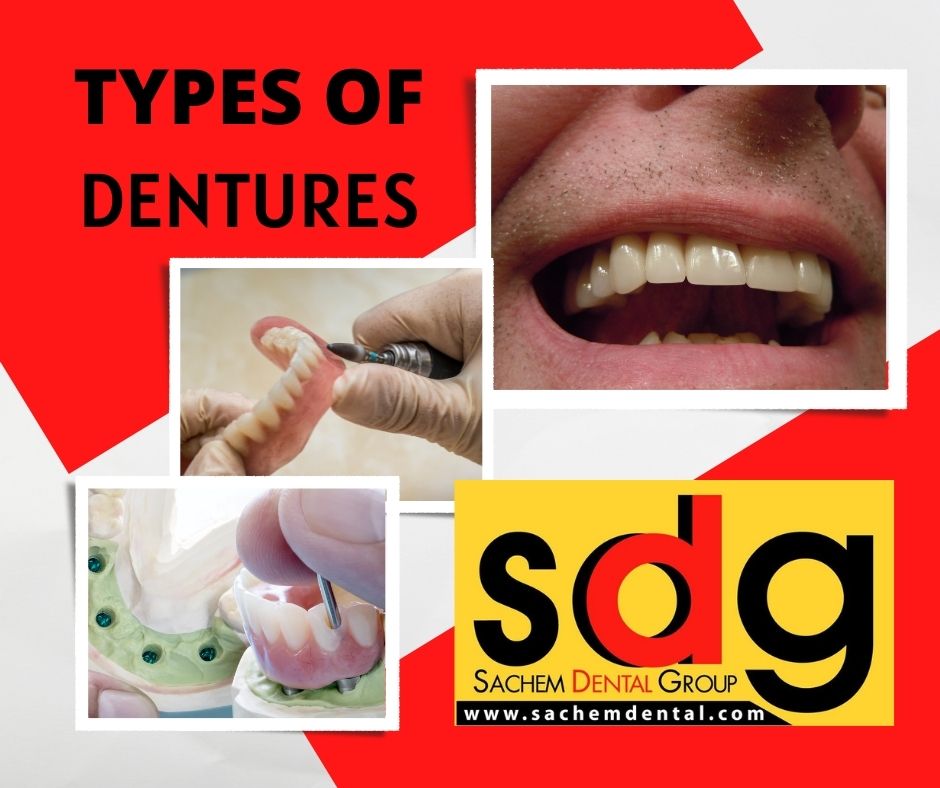
If you’re missing several or all of your teeth, then a denture may be the best solution to replace all of them at once. However, this doesn’t mean that you have to settle for the same old “plates” that your grandma once wore. In this day and age, there are several denture options and designs to consider. Here are just some of the tooth replacement and denture options available from our Long Island dentist.
Traditional Removable Dentures
A traditional removable denture is an all-acrylic appliance that rests directly on top of your gums. They replace all of the teeth in your arch at one time, assuming you no longer have any natural teeth to retain.
The upper arch denture stays in place by covering the roof of your mouth and creating a suction with your palate. Most people can wear a traditional upper denture comfortably. However, there are some downfalls to this appliance. For instance, if you have a shallow palate or jaw, then you may find that your denture feels slightly loose, and you may have to wear denture adhesive to help hold it securely in place. Also, since the plate covers your entire palate and extends to the back of your mouth, people with a strong gag reflex may have a difficult time wearing this type of prosthesis. The bulky acrylic also covers some of your taste buds, affecting the way that you eat and taste your food. It can also impair your speech.
The lower denture, which is typically harder to keep in place, sits on your bone ridge. It has no way to form as tight of a fit as your top denture. Some people lack a substantial amount of lower bone, making it even more difficult to wear a lower denture. In this case, denture adhesive can be worn in some situations, but wearing this lower appliance can still be somewhat of an issue.
Implant-Supported Overdentures
An implant-supported overdenture is a traditional denture that snaps onto implants for added stability and comfort throughout the day.
The first step in getting this particular appliance is to strategically place anywhere from 2-4 throughout each arch. These implants don’t make the denture permanent, but they do provide a stable grip to prevent the prosthesis from shifting around throughout the day. As a result, no denture adhesive is necessary.
Anytime we place implants, the surrounding bone needs at least 12 weeks to naturally fuse to the titanium posts before proper stabilization is achieved or force is applied. In the meantime, you’ll wear a regular-looking denture that doesn’t incorporate an attachment with your new implants. Once your implant posts are fully integrated, we’ll attach a small extension to them which will protrude out of the gum tissues just slightly. We’ll also take your current denture 一 or make you a new one 一 and put small silicone attachments in them to line up with each implant. From then on, you’ll be able to snap/clip/attach your overdenture onto your implants, making for a stable plate.
You’ll still need to remove your overdenture every night before you go to bed and clean it thoroughly each day.
After a prolonged period of removing and inserting your overdenture, the washers will wear out and the plate will lose retention. When this happens, all you need to do is have our dentist swap the old attachments out for some new ones. The denture and implants themselves will last for several years.
Implant-supported dentures are a great middle-ground for someone who needs better security from their traditional denture, but doesn’t want or qualify for an All-on-4 treatment.
Permanent “All-On-4” or “All-on-6” Hybrid Dentures
An All-on-4 treatment is a hybrid type of overdenture with one big difference. The horseshoe-shaped prosthesis is permanently attached to your mouth (similar to a fixed implant bridge) and only covers the curved contour of your jaw, instead of your palate. It’s called an “All-on-4” or “All-on-6” because only 4-6 implants are needed to support a full arch of 14 teeth.
This type of prosthesis can only be removed by a dentist, so you’ll never need to worry about it coming out during mealtimes or conversations with friends.
All-on-4 types of implants offer the best of both worlds, because they’re cost-effective, maximize fewer implants required, and never need to be removed at night. You’ll find that you feel more confident and are able to enjoy more foods than you would with a traditional denture.
Partial Dentures
A partial denture is ideal if you’re missing several teeth but still have several healthy ones left. Partials are a common alternative to implant-supported bridges.
This appliance is typically made completely from acrylic or with a metal base, for a more durable and longer-lasting solution. Each partial is custom-made and will have the specific teeth attached to it, depending on which ones you are missing. We also take into consideration the size, shape, and color of the teeth, to try to give you a seamless appearance between your natural teeth and the ones on your partial.
Partials use small extensions known as clasps, which hug the teeth you still have for security throughout the day. Typically, the clasps are enough to hold the appliance in place, making the need for denture adhesive obsolete.
These appliances do need to be removed every night before bed and it’s a good idea to take them out and brush them after every meal.
Which Type Of Denture Is Right For Me?
To determine what denture is right for you we’ll need to evaluate the teeth you still have, the condition of your bone ridge, and the bone level along with some of your other facial anatomy, like specific nerves and your sinus cavities. When you come in for your denture consultation, we may take a 3-D X-ray to help us make the best recommendation for your specific treatment needs.
If you’re ready to replace your missing teeth, give Sachem Dental Group in Suffolk County a call today.
